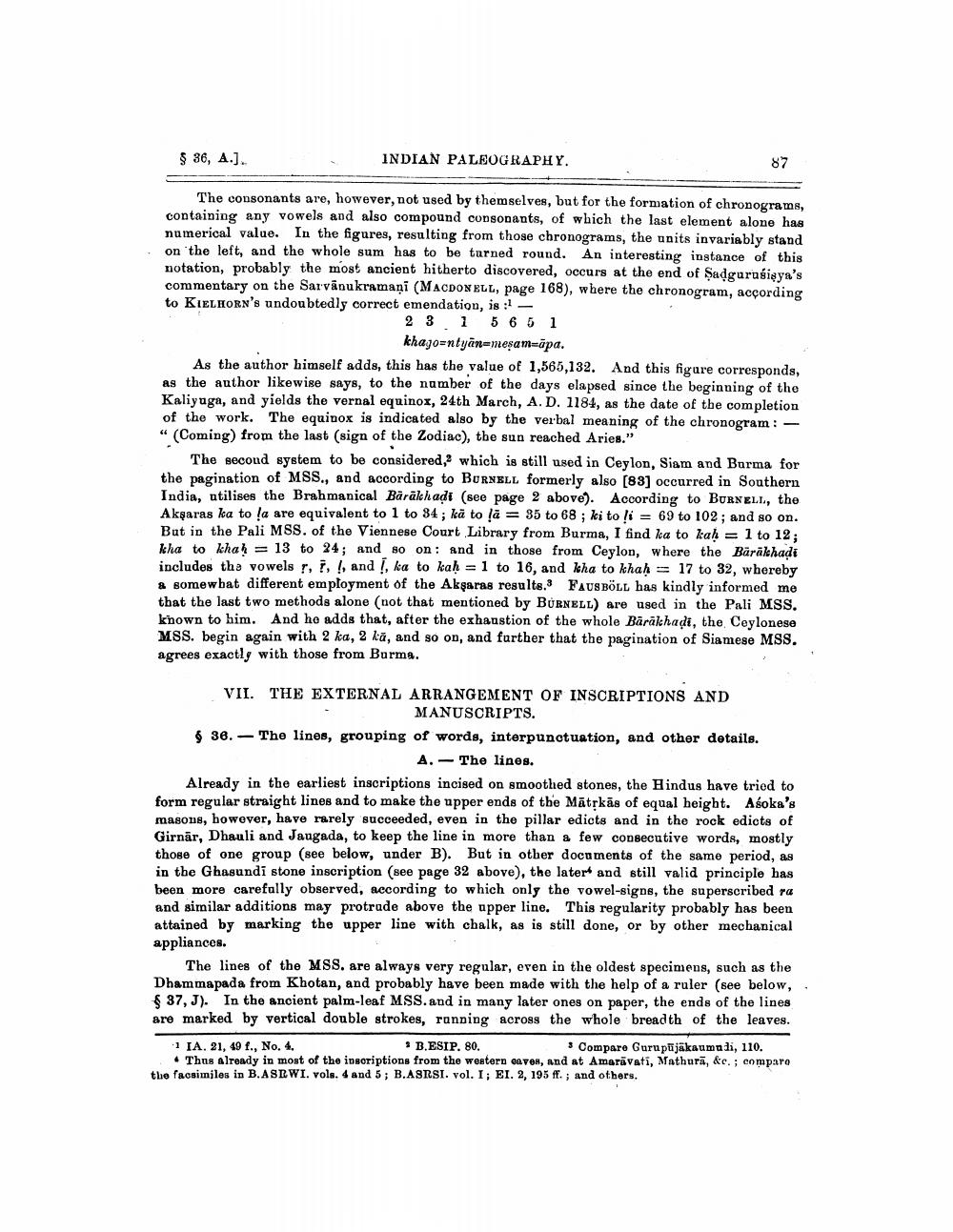________________
$36, A.].
INDIAN PALEOGRAPHY.
87
The consonants are, however, not used by themselves, but for the formation of chronograms, containing any vowels and also compound consonants, of which the last element alone has numerical value. In the figures, resulting from those chronograms, the units invariably stand on the left, and the whole sum has to be tarned round. An interesting instance of this notation, probably the most ancient hitherto discovered, occurs at the end of Sadgurusiaya's commentary on the Sarvanukramaņi (MACDONBLL, page 168), where the chronogram, according to KUELHORN's undoubtedly correct emendation, is: -
2 3 1 5 6 5 1
khajo=ntyān=mesam=āpa. As the author himself adds, this has the value of 1,565,132. And this figure corresponds, as the author likewise says, to the number of the days elapsed since the beginning of the Kaliyuga, and yields the vernal equinox, 24th March, A.D. 1184, as the date of the completion of the work. The equinox is indicated also by the verbal meaning of the chronogram: - “ (Coming) from the last (sign of the Zodiac), the sun reached Aries."
The second system to be considered, which is still used in Ceylon, Siam and Burma for the pagination of MSS., and according to BURNELL formerly also [83] occurred in Southern India, utilises the Brahmanical Bārākhadi (see page 2 above). According to BURNELL, the Akşaras ka to !a are equivalent to 1 to 34 ; kā to a = 35 to 68 ; ki to li = 69 to 102; and so on. But in the Pali MSS. of the Viennese Court Library from Burma, I find ka to kah = 1 to 12; kha to khah = 13 to 24; and so on and in those from Ceylon, where the Bārākhadi includes the vowels , !, !, and !, ka to kah = 1 to 16, and kha to khah = 17 to 32, whereby & somewbat different employment of the Akşaras results. FAUS BÖLL has kindly informed me that the last two methods alone (not that mentioned by BURNELL) are used in the Pali MSS. known to him. And he adds that, after the exhaustion of the whole Bārākhadi, the Ceylonese MSS. begin again with 2 ka, 2 kä, and so on, and further that the pagination of Siamese MSS. agrees exactly with those from Burma.
VII. THE EXTERNAL ARRANGEMENT OF INSCRIPTIONS AND
MANUSCRIPTS. 38. -The lines, grouping of words, interpunctuation, and other details.
A. - The lines. Already in the earliest inscriptions incised on smoothed stones, the Hindus have triod to form regular straight lines and to make the upper ends of the Mätskās of equal height. Asoka's masons, however, have rarely succeeded, even in the pillar edicts and in the rock edicts of Girnar, Dhauli and Jaugada, to keep the line in more than a few consecutive words, mostly those of one group (see below, under B). But in other documents of the same period, as in the Ghasundi stone inscription (see page 32 above), the later and still valid principle has been more carefully observed, according to which only the vowel-signs, the superscribed ra and similar additions may protrade above the upper line. This regularity probably has been attained by marking the upper line with chalk, as is still done, or by other mechanical appliances.
The lines of the MSS. are always very regular, eren in the oldest specimens, such as the Dhammapada from Khotan, and probably have been made with the help of a ruler (see below, $ 37,J). In the ancient palm-leaf MSS. and in many later ones on paper, the ends of the lines are marked by vertical double strokes, running across the whole breadth of the leaves. 1 IA. 21, 49 f., No. 4.
BESIP. 80.
Compare Gurupājākaumudi, 110. • Thus already in most of the insoriptions from the western caves, and at Amaravati, Mathurā, &c.; compare the facsimiles in B. ASRWI. vols. 4 and 5; B.ASRSI. vol. I; EI. 2,195 fl.; and others.




